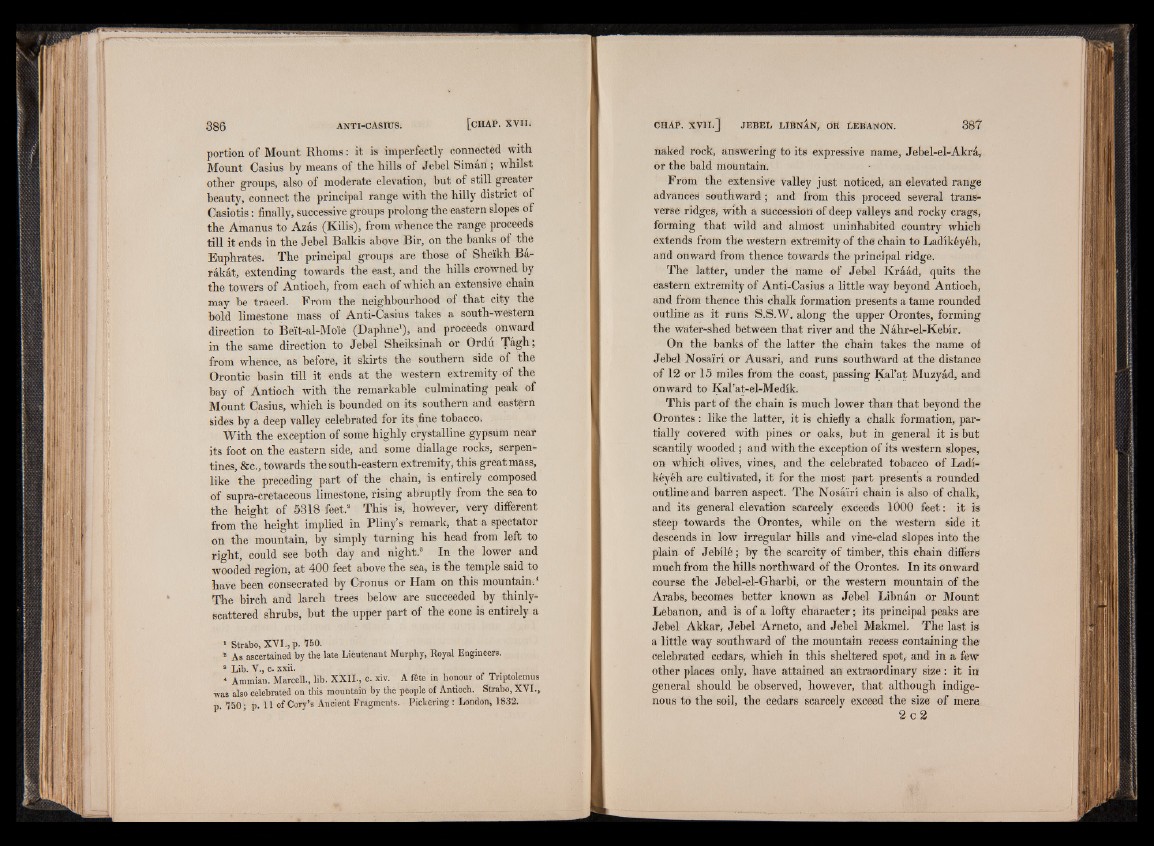
portion of Mount Rhoms : it is imperfectly connected with
Blount Casius by means of the hills of Jebel Siman ; whilst
other groupsj also of moderate elevation, but of still greater
beauty, connect the principal range with the hilly district of
Casiotis : finally, successive groups prolong the eastern slopes of
the Amanus to Azâs (Kilis), from whence the range proceeds
till it ends in the Jebel Balkis above Bir, on the banks of the
Euphrates. The principal groups are those of Shei'kh Bâ-
râkât, extending towards the east, and the hills crowned by
the towers of Antioch, from each of which an extensive chain
may be traced. From the neighbourhood of that city the
bold limestone mass of Anti-Casius takes a south-western
direction to Beït-al-Bloïe (Daphne1), and proceeds onward
in the same direction to Jebel Sheiksinah or Ordu Tagh,
from whence, as before, it skirts the southern side of the
Orontic basin till it ends at the western extremity of the
bay of Antioch with the remarkable culminating peak of
Mount Casius, which is bounded on its southern and eastern
sides by a deep valley celebrated for its fine tobacco,
With the exception of some highly crystalline gypsum neat
its foot on the eastern side, and some diallage rocks, serpentines,
&c., towards the south-eastern extremity, this great mass,
like the preceding part of the chain, is entirely composed
of supra-crètaceous limestone, rising abruptly from the sea to
the height of 5318 feet.2 This is, however, very different
from the height implied in Pliny s remark, that a spectator
on the mountain, by simply turning his head from left to
right, could see both day and night.8 In the lower and
wooded region, at 400 feet above the sea, is tbe temple said to
have been consecrated by Cronus or Ham on this mountain.4
The birch and larch trees below are succeeded by thinly-
scattered shrubs, but the upper part of the cone is entirely a
1 Strabo, XVI., p. *750.
3 As ascertained by the late Lieutenant Murphy, Royal Engineers.
3 Lih. V., c. xxii.
4 Ammian. Marceli., lih. XXII., c. xiv. A fête in honour of Triptolemus
■was also celebrated on this mountain by thè people of Antioch. Strabo, XVI.,
p. 750; p. 11 of Cory’s Ancient Fragments. Pickering : London, 1832.
naked rock, answering to its expressive name, Jebel-el-Akra,
or the bald mountain.
From the extensive valley just noticed, an elevated range
advances southward; and from this proceed several transverse
ridges, with a succession of deep valleys and rocky crags,
forming that wild and almost uninhabited country which
extends from the western extremity of the chain to Ladikfeyeb,
and onward from thence towards the principal ridge.
The latter, under the name of Jebel Kraad, quits the
eastern extremity of Anti-Casius a little 'Way beyond Antioch,
and from thence this chalk formation presents a tame rounded
outline as it runs S.S.W. along the upper Orontes, forming
the water-shed between that river and the Nahr-el-Kebir.
On the banks of the latter the chain takes the name of
Jebel Nosairi or Ausari, and runs southward at the distance
of 12 or 15 miles from the coast, passing Kal’at Muzyad, and
onward to Kal’at-el-Medik.
This part of the chain is much lower than that beyond the
Orontes : like the latter, it is chiefly a chalk formation, partially
covered with pines or oaks, but in general it is but
scantily wooded ; and with the exception of its western slopes,
on which olives, vines, and the celebrated tobacco of Ladi-
k£y6h are cultivated, it for the most part presents a rounded
outline and barren aspect. The Nosairi chain is also of chalk,
and its general elevation scarcely exceeds 1000 feet: it is
steep towards the Orontes, while on the western side it
descends in low irregular hills and vine-clad slopes into the
plain of J eb ileb y the scarcity of timber, this chain differs
much from the hills northward of the Orontes. In its onward
course the Jebel-el-Gharbi, or the western mountain of the
Arabs, becomes better known as Jebel Libnan or Blount
Lebanon, and is of a lofty character; its principal peaks are
Jebel Akkar, Jebel Arneto, and Jebel Makmel. The last is
a little way southward of the mountain recess containing the
celebrated cedars, which in this sheltered spot, and in a few
other places only, have attained an extraordinary size: it in
general should be observed, however, that although indigenous
to the soil, the cedars scarcely exceed the size of mere
2 c 2